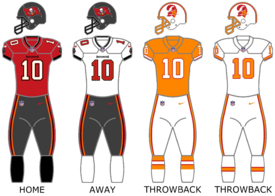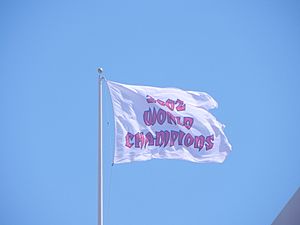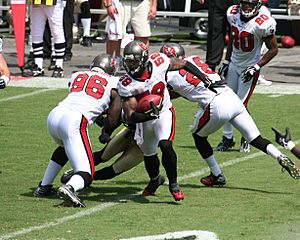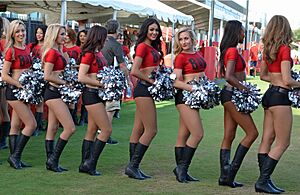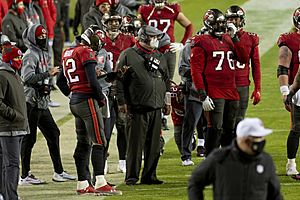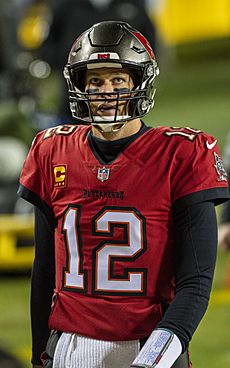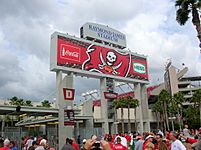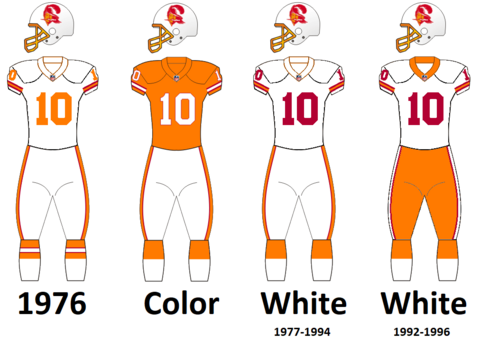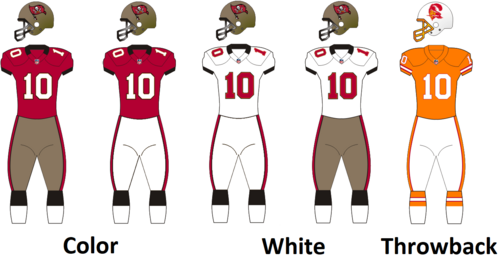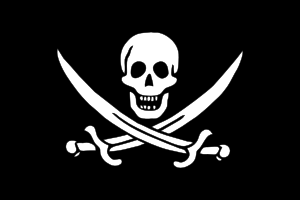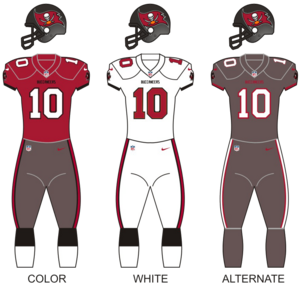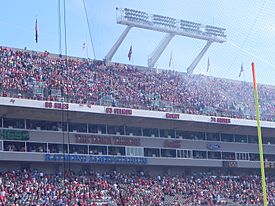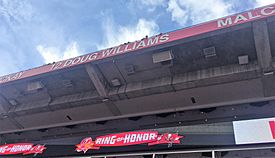Tampa Bay Buccaneers facts for kids
Quick facts for kids Tampa Bay Buccaneers |
|||||||||||||
|---|---|---|---|---|---|---|---|---|---|---|---|---|---|
|
|||||||||||||
| Basic info | |||||||||||||
| Established | April 24, 1974 | ||||||||||||
| Stadium | Raymond James Stadium, Tampa, Florida |
||||||||||||
| Headquartered | One Buccaneer Place, Tampa, Florida |
||||||||||||
| Colors | Buccaneer red, pewter, orange, black |
||||||||||||
| Fight song | "Hey! Hey! Tampa Bay!" | ||||||||||||
| Mascot | Captain Fear | ||||||||||||
| Personnel | |||||||||||||
| Owner(s) | Glazer family | ||||||||||||
| Chairman |
|
||||||||||||
| President | Darcie Glazer Kassewitz | ||||||||||||
| General manager | Jason Licht | ||||||||||||
| Head coach | Todd Bowles | ||||||||||||
| Nicknames | |||||||||||||
|
|||||||||||||
| Team history | |||||||||||||
|
|||||||||||||
| Home fields | |||||||||||||
|
|||||||||||||
| League / conference affiliations | |||||||||||||
National Football League (1976–present)
|
|||||||||||||
| Championships | |||||||||||||
League championships: 2
|
|||||||||||||
Conference championships: 2
|
|||||||||||||
Division championships: 10
|
|||||||||||||
| Playoff appearances (15) | |||||||||||||
|
|||||||||||||
| Owner(s) | |||||||||||||
|
|||||||||||||
The Tampa Bay Buccaneers, often called the Bucs, are a professional American football team from Tampa, Florida. They play in the National Football League (NFL) as part of the National Football Conference (NFC) South division. The Buccaneers joined the NFL in 1974 as a new team, along with the Seattle Seahawks. They played their first season in the American Football Conference (AFC) West division.
Before the 1977 season, Tampa Bay and Seattle switched conferences. The Buccaneers moved to the NFC Central division. The Seahawks later rejoined the NFC in 2002. This made the Buccaneers the only NFL team not to play in their original conference. In 2002, the league changed its divisions, and the Buccaneers joined three former NFC West teams to form the NFC South. The Glazer family owns the team, and they play their home games at Raymond James Stadium in Tampa.
The Buccaneers have won two Super Bowl championships. They are one of only two NFL teams, along with the Baltimore Ravens, that have won every Super Bowl they have played in more than once. For their first 20 years, the team was known for losing a lot. They lost 26 games in a row in their first two seasons, including a season with no wins. They also had 14 losing seasons in a row from 1983 to 1996, which is the most in NFL history.
Despite these tough beginnings, Tampa Bay was the first new team after the AFL–NFL merger to win a division title, win a playoff game, and host a conference championship. They did all of this by their fourth season in 1979. The team's image got much better by the time they won their first championship in Super Bowl XXXVII in 2002. This was also the first Super Bowl win for any of the six teams created after the merger. They did not win another playoff game until their second Super Bowl championship season in Super Bowl LV in 2020. In the 2024 season, the team tied the New Orleans Saints for the most NFC South division titles with seven. The 2024 season also set new team records with four division titles in a row and five playoff appearances in a row.
Contents
- Team History
- Early Years: The Hugh Culverhouse Era (1976–1994)
- The Glazer Family Era (1995–Present)
- Tony Dungy's Impact (1996–2001)
- Jon Gruden's Era and Super Bowl XXXVII (2002–2008)
- Raheem Morris Takes Over (2009–2011)
- Greg Schiano's Time (2012–2013)
- Lovie Smith's Return (2014–2015)
- Dirk Koetter's Coaching (2016–2018)
- Bruce Arians' Success and Super Bowl LV (2019–2021)
- Todd Bowles' Leadership (2022–Present)
- Team Defense
- Team Facilities
- Team Logos and Uniforms
- Team Records and Achievements
- Notable Players
- Team Staff and Coaches
- Team Culture
- Team Rivalries
- Radio and Television
- See also
Team History
Early Years: The Hugh Culverhouse Era (1976–1994)
Starting Out with John McKay (1976–1984)
The Buccaneers joined the NFL in 1976 in the AFC West. The next year, they moved to the NFC Central. This move was planned by the league so that the two new teams, Tampa Bay and Seattle, could play each other twice and every other NFL team once in their first two years.
Tampa Bay had a tough first season, losing all 14 games. They were often outscored by about 21 points per game. Until the Detroit Lions in 2008, the 1976 Bucs were the only team in the Super Bowl era to have a winless season. Their losing streak became a joke on TV shows. The Buccaneers did not win their first game until the 13th week of their second season. This meant they started with a record of 0 wins and 26 losses. Their first win was on December 11, 1977, against the New Orleans Saints. The Saints' coach was fired after this loss. The Bucs won their second game the next week against the St. Louis Cardinals.
The Buccaneers got better in 1978, finishing 5–11. They had a strong defense that was seventh best in the league for points allowed. The team improved quickly in the 1979 season. With quarterback Doug Williams, tight end Jimmie Giles, running back Ricky Bell, and a top defense led by future Hall of Famer Lee Roy Selmon, the Bucs started with five wins in a row. This put them on the cover of Sports Illustrated.
The Bucs needed to win just one of their last four games to make the playoffs. They lost three close games. However, in their final game against the Kansas City Chiefs, played in a huge rainstorm, Tampa Bay won 3–0. They finished 10–6, their first winning season ever, and won the Central Division. In the playoffs, they upset the Philadelphia Eagles 24–17. They then hosted the NFC Championship Game but lost to the Los Angeles Rams 9–0. The Bucs seemed to be on their way to success. However, they struggled in 1980, finishing 5–10–1.
The Buccaneers made the playoffs again in the 1981 season by winning their division. They won a thrilling final game against the Detroit Lions. In the playoffs, the Dallas Cowboys beat the Bucs 38–0. This is still the team's biggest playoff shutout loss.
The 1982 season started 0–3 before a player strike stopped the NFL for seven weeks. When games started again, the Bucs were called the "Cardiac Kids" because they won five of their next six games in the final moments. They finished 5–4 and made the playoffs. They lost to the Cowboys again, 30–17. This was the last winning season under owner Hugh Culverhouse.
Before the 1983 season, quarterback Doug Williams left due to a contract dispute. The Bucs lost their first nine games in 1983 and finished 2–14. This was the start of 12 seasons in a row with at least ten losses, an NFL record. In the 1986 draft, they picked Heisman Trophy winner Bo Jackson first overall. But Jackson refused to play for Tampa Bay and chose to play baseball instead. Other Bucs quarterbacks from this time, like Steve Young and Trent Dilfer, later won Super Bowls with other teams. In 1984, the team finished 6–10 in John McKay's last season as coach.
Leeman Bennett coached the team to 2–14 records in 1985 and 1986 before being fired. Ray Perkins took over in 1987 and coached for almost four seasons, but the team never won more than five games in a season.
Under Culverhouse, the Bucs made money in the 1980s because they kept player salaries very low. This made it hard to sign good players. Attendance at games also dropped. For a while, home games were not shown on local TV.
Later, the team drafted important players like Hardy Nickerson (1993), John Lynch (1993), Warren Sapp (1995), Derrick Brooks (1995), and Mike Alstott (1996). Many of these players became Hall of Famers.
The Glazer Family Era (1995–Present)
Hugh Culverhouse passed away in 1994. His son sold the team for $192 million. Many people wanted to buy the team, including New York Yankees owner George Steinbrenner. Some even wanted to move the team to Baltimore.
However, Malcolm Glazer, a real estate businessman, bought the team for $192 million, which was the highest price for a sports team at that time. Glazer said he would keep the team in Tampa. He convinced voters in Hillsborough County to raise sales taxes to build a new stadium, which became Raymond James Stadium.
Tony Dungy's Impact (1996–2001)
The Glazer family invested a lot in the team, and the Bucs finally started to win. They hired Tony Dungy as head coach, who was known for his defensive strategies. The team also got new uniforms.
In Dungy's first season in 1996, the team started 1–8 but finished strong with a 5–2 record. This was thanks to a strong defense led by Hardy Nickerson, Derrick Brooks, John Lynch, and Warren Sapp. Dungy's calm personality helped the team. His "Cover 2" defensive strategy, perfected by defensive coordinator Monte Kiffin, became famous as the "Tampa 2". Many other teams copied it.
The team started the 1997 season with five wins in a row. They finished 10–6, their first winning season and playoff appearance since 1982. They beat the Lions 20–10 in their last game at Houlihan's Stadium (formerly Tampa Stadium). They lost to the Green Bay Packers in the playoffs, but there was a lot of hope for the future.
The 1998 season was the first in the new Raymond James Stadium. The Bucs lost several close games and finished 8–8.
The 1999 season was much better. With the NFL's third-best defense and good play from rookie quarterback Shaun King, the Bucs finished 11–5 and won their third NFC Central Division Championship. They beat the Washington Redskins 14–13 in the playoffs. They then lost a close NFC Championship Game to the St. Louis Rams 11–6. The loss was controversial because a catch by receiver Bert Emanuel was overturned. After the season, the NFL changed the rules about what counts as an incomplete pass.
The Bucs played well in 2000 and 2001, making the playoffs each year. However, they lost both times in cold weather games against the Philadelphia Eagles. The Buccaneers often struggled in very cold temperatures.
Jon Gruden's Era and Super Bowl XXXVII (2002–2008)
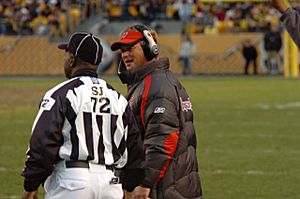
Tony Dungy was fired after the 2001 season. The Bucs then hired Jon Gruden as head coach on February 20, 2002. Gruden was still under contract with the Oakland Raiders, so the Bucs had to trade four draft picks and $8 million to get him. Gruden was happy to return to Tampa Bay, where he had spent part of his childhood.
Gruden immediately worked to improve the team's offense. The league's new divisions put the Bucs in the NFC South with the Falcons, Carolina Panthers, and Saints.
Super Bowl XXXVII Champions (2002)
The 2002 season was the team's most successful. They had the league's best defense, led by Derrick Brooks, who was named NFL Defensive Player of the Year. They won the NFC South title with a 12–4 record. In the playoffs, they beat the 49ers and then the Eagles, who had beaten them in the playoffs the past two years. Ronde Barber sealed the win against the Eagles with an interception returned for a touchdown, making the score 27–10. The Bucs then easily beat Gruden's former team, the Raiders, 48–21 in Super Bowl XXXVII. This game was nicknamed 'The Pirate Bowl'.
After the Super Bowl win, there were reports that Gruden and general manager Rich McKay were not getting along. McKay left the Bucs in December 2003 and joined the Falcons. The Bucs struggled in the 2003 season, finishing 7–9.
In 2004, Bruce Allen became the new general manager. He released key players like John Lynch and Warren Sapp, which surprised many fans. The Bucs started the 2004 season 1–5 and finished 5–11.
In the 2005 season, the Buccaneers celebrated their 30th year. They drafted Carnell "Cadillac" Williams, who gave them a strong running game. Williams won the NFL Offensive Rookie of the Year Award. The team started 5–1 but struggled after quarterback Brian Griese was injured. Replacement quarterback Chris Simms led them to a division title with an 11–5 record. However, they lost in the first round of the playoffs to the Redskins.
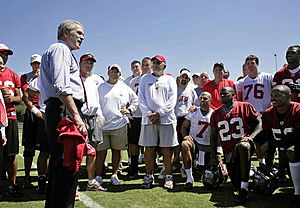
The 2006 season was tough due to many player injuries. The team finished 4–12. The defense, which had been strong for years, was not in the top ten for the first time since 1996.
In 2007, the Bucs signed new players like quarterback Jeff Garcia. They won the NFC South title with a 9–7 record. In the playoffs, they lost to the eventual Super Bowl champion Giants 24–14.
In 2008, the Bucs started strong with a 9–3 record. However, they lost their last four games and finished 9–7, missing the playoffs. Defensive coordinator Monte Kiffin announced he would leave after the season.
Raheem Morris Takes Over (2009–2011)
After the 2008 season, Jon Gruden was fired. Raheem Morris was promoted to head coach, and Mark Dominik became general manager. Many veteran players were released. The team finished the 2009 season with a 3–13 record.
The 2010 season was a big surprise. The team improved to 10–6, thanks to good play from quarterback Josh Freeman and rookie receiver Mike Williams. They just missed the playoffs.
The 2011 season started with high hopes but ended with ten losses in a row, finishing 4–12. Morris and his coaching staff were fired. During this time, attendance at games dropped, and some home games were not shown on local TV.
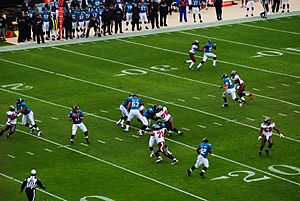
Greg Schiano's Time (2012–2013)
In 2012, the Buccaneers hired Greg Schiano as their new head coach. He promised a "Buccaneer Way" of playing. The team signed top players like Vincent Jackson and Carl Nicks.
The team finished the 2012 season 7–9. They were very good at stopping the run. Running back Doug Martin had a great season. Attendance improved, and some TV blackouts were lifted. However, Schiano's strict coaching style caused some controversy, especially after a game against the Giants where he told his defense to keep tackling even when the game was ending.
The 2013 season was disappointing. The team had issues with players getting infections. There were also problems between Schiano and quarterback Josh Freeman, who was eventually released. The team started 0–8 but then won some games. They finished 4–12. Schiano and general manager Mark Dominik were fired on December 30, 2013.
Lovie Smith's Return (2014–2015)
On January 1, 2014, Lovie Smith was hired as the new head coach. Smith had coached linebackers for the Bucs from 1996 to 2001. He wanted to bring back the team's winning ways from the late 1990s. Jason Licht was hired as the new general manager.
Many thought the Bucs would do well in 2014, but they started 0–3. They finished the season 2–14, which was tied for the worst record in the NFL. This gave them the first pick in the 2015 NFL draft.
Despite the team's record, rookie wide receiver Mike Evans had over 1,000 receiving yards. He became the youngest NFL player to have over 200 receiving yards in one game.
On January 6, 2016, Smith was fired after two seasons with an 8–24 record.
Dirk Koetter's Coaching (2016–2018)
On January 15, 2016, Dirk Koetter was promoted from offensive coordinator to head coach. In 2016, the team won five games in a row, their longest streak since 2002. They finished with a 9–7 record but missed the playoffs.
In 2017, the team started 2–6 and finished 5–11. This was their tenth season in a row without making the playoffs.
The 2018 season started 2–0. Quarterback Ryan Fitzpatrick played very well while Jameis Winston was suspended. Fitzpatrick became the first NFL player to throw for over 400 yards in three games in a row. However, the team struggled later in the season and finished 5–11. Koetter was fired after the season.
Bruce Arians' Success and Super Bowl LV (2019–2021)
On January 8, 2019, Bruce Arians became the 12th head coach. He had retired from coaching for a year. The Bucs also hired Byron Leftwich as offensive coordinator and Todd Bowles as defensive coordinator.
In 2019, Tampa Bay finished 7–9. They had the best run defense in the league. Quarterback Jameis Winston set team records with 5,109 passing yards and 33 touchdown passes. However, he also threw a league-leading 30 interceptions. Winston was not re-signed by the team.
Super Bowl LV Champions (2020)
The Buccaneers made a huge move in 2020 by signing veteran quarterback Tom Brady, who is considered one of the greatest players ever. Brady had played 20 seasons with the New England Patriots before joining the Bucs.
Later, tight end Rob Gronkowski, who had played with Brady in New England, came out of retirement to join the Buccaneers. The team also signed running back Leonard Fournette and wide receiver Antonio Brown.
In the 2020 season, Tampa Bay made the playoffs for the first time since 2007. Brady set a team record with 40 passing touchdowns. Receiver Mike Evans set an NFL record with seven straight seasons of over 1,000 receiving yards to start his career.
In the playoffs, the Buccaneers beat the Washington Football Team 31–23, their first playoff win since 2002. They then beat the Saints 30–20 to reach the NFC Championship Game. They defeated the Packers to advance to Super Bowl LV, where they faced the defending champion Kansas City Chiefs. The Bucs won their second Super Bowl title, beating the Chiefs 31–9. Raymond James Stadium was chosen to host Super Bowl LV, making the Buccaneers the first team in NFL history to play in and win a Super Bowl in their home stadium.
In 2021, the Buccaneers re-signed all 22 of their starters from the Super Bowl team. This was the first time a team in the salary cap era (since 1994) had done this.
After the 2021 regular season, where they had a 13–4 record, the team beat the Philadelphia Eagles 31–15 in the Wild Card Round. However, their title defense ended with a close 30–27 loss to the Los Angeles Rams in the Divisional Round.
Todd Bowles' Leadership (2022–Present)
On February 1, 2022, quarterback Tom Brady announced his retirement. However, he changed his mind on March 13 and returned for the 2022 season. On March 30, head coach Bruce Arians retired, and defensive coordinator Todd Bowles was named his replacement.
Despite signing several new players, the Buccaneers struggled in Bowles' first season as head coach. They finished 8–9 but still won the NFC South division title. They lost at home to the Cowboys in the Wild Card Round. On February 1, 2023, Brady announced his retirement "for good."
In 2023, Tampa Bay hired Dave Canales as offensive coordinator and signed Heisman Trophy winner Baker Mayfield as their new starting quarterback. The Buccaneers won the NFC South with a 9–8 record, their third division title in a row. They beat Philadelphia 32–9 in the Wild Card Round. Their season ended with a 31–23 loss to the Detroit Lions in the Divisional Round.
In the 2024 offseason, Baker Mayfield signed a new contract to stay as quarterback. The Buccaneers finished the 2024 regular season 10–7, winning the NFC South for a team-best fourth season in a row. This also tied the record for most consecutive NFC South titles. It was also the team's fifth playoff appearance in a row, a new team and division record. Mayfield threw 41 touchdown passes, and the offense was third best in the league. Wide receiver Mike Evans finished with over 1,000 receiving yards, tying the NFL record for most consecutive seasons with 1,000+ receiving yards (11). In the playoffs, they were upset by the Washington Commanders 20–23.
Team Defense
The Buccaneers have always been known for their strong defense. It started with drafting Hall of Fame defensive end Lee Roy Selmon in 1976. Three Buccaneers have won the AP NFL Defensive Player of the Year Award, and the team has led the league in total defense three times, including their 2002 championship season. The defense was key to their 2020 playoff run and second Super Bowl title. All five of the Buccaneers' Hall of Fame players are defensive players or coaches.
Early Defensive Strength (1978–1982)
Led by Selmon, linebackers Dewey Selmon, Richard Wood, and Dave Lewis, and defensive backs Mike Washington, Mark Cotney, and Cedric Brown, the early Bucs were known for their defense. Their 3–4 defense was best in 1979, leading the league in total defense and points allowed. Lee Roy Selmon was named NFL Defensive Player of the Year.
The Famous Tampa 2 Defense (1997–2008)
The team drafted important players like Warren Sapp and Derrick Brooks in 1995. Then, they hired defensive coordinator Monte Kiffin in 1996. This set the stage for one of the best defensive periods in NFL history. From 1997 to 2008, the Buccaneers defense was in the league's top ten almost every year. Kiffin and head coach Tony Dungy created the "Tampa 2" defense, a special version of the "Cover 2" scheme.
Kiffin's defenses were known for their fast, hard-hitting players who caused many turnovers. Many teams tried to copy the Tampa 2, but none were as successful as the Buccaneers. The Tampa Bay defense featured future Hall of Famers like Derrick Brooks, John Lynch, Warren Sapp, and Ronde Barber.
The Incredible 2002 Defense
The 2002 Buccaneers defense is considered one of the greatest defenses in NFL history. In the regular season, Tampa Bay led the league in total defense, points allowed, and interceptions. Derrick Brooks won AP Defensive Player of the Year. The team was even better in the playoffs, allowing only 37 points in three games.
In Super Bowl XXXVII, the Buccaneers' defense played amazingly. They intercepted the Raiders' quarterback five times, returning three for touchdowns. This set two Super Bowl records. Defensive back Dwight Smith was the only player in Super Bowl history to have two interception returns for touchdowns. Dexter Jackson won Super Bowl MVP for his two interceptions. In 2002, the Buccaneers had 40 interceptions, 53 sacks, and 9 defensive touchdowns in total.
Todd Bowles' 3–4 Defense (2019–Present)
When Bruce Arians became head coach in 2019, he made Todd Bowles the defensive coordinator. The team drafted linebacker Devin White and signed Shaquil Barrett and Ndamukong Suh. With these players, Bowles used a "3–4 defensive scheme" that focused on blitzing. Barrett led the league with 19.5 sacks in 2019, and the Bucs had the best run defense.
The defense got even better in 2020. They finished first in run defense and seventh in pass defense. Their young defensive backs, like Carlton Davis and Antoine Winfield Jr., played a big part. In Super Bowl LV, the Buccaneers' defense held the Kansas City Chiefs' top offense to only 9 points. They forced two interceptions and had three sacks. In 2020, the Buccaneers had 18 interceptions, 58 sacks, and 19 forced fumbles in total.
Team Facilities
Since 1998, the Buccaneers have played their home games at Raymond James Stadium in Tampa. Before that, they played at Tampa Stadium from the team's start.
In 1975, the Buccaneers built a small practice area called One Buccaneer Place. It was used until 2005. Players and coaches often complained about the noise from the nearby airport, small offices, and other problems. Coach Jon Gruden jokingly called it "The Woodshed."
In 2006, the Buccaneers opened a new $30 million training facility. It is located across the street from Raymond James Stadium. This modern facility has offices, meeting rooms, three grass practice fields, a theater, a large weight room, a kitchen, and a rehabilitation center. In 2017, an indoor practice field was added. Since 2009, the team has held its training camp at this new complex.
In 2007, statues of important players and coaches from the 2002 championship season were placed in the lobby. These included players like Mike Alstott, Derrick Brooks, and Warren Sapp, and coach Jon Gruden. In 2018, the facility was officially named Advent Health Training Facility.
Team Logos and Uniforms
Team Logos
The Buccaneers have had two main logo and uniform styles. From 1976 to 1996, they used orange, red, and white uniforms with a "Bucco Bruce" logo. Since 1997, they have used red and pewter uniforms with a "skull and swords" logo.
The "Bucco Bruce" logo had a few small changes over the years. The "skull and swords" logo also had some updates, becoming larger on the helmet and changing slightly in design.
The Original Look (1976)
In 1975, the team chose the name "Buccaneers" and planned to use green, orange, and white colors. Orange was chosen to represent Florida's citrus industry. However, green was soon dropped because it looked too much like other Florida teams' colors. Red was added as an accent color. The official colors were Florida orange, red, and white.
A local cartoonist named Lamar Sparkman designed the first team logo. He created a pirate with a mustache, a feathered hat, an earring, and a dagger in his teeth. The pirate was winking. Sportswriter Hubert Mizell gave the logo the nickname "Bucco Bruce," which stuck. Many people thought Bucco Bruce looked friendly, not scary.
The first home uniforms were orange jerseys with white numbers, white pants, and striped socks. These were called the "Creamsicle uniforms" because they looked like the ice cream treat. In their first season (1976), the Bucs only wore their white jerseys for regular season games.
Changes to the Original Look (1977–1991)
After one season, the numbers on the white "away" jerseys were changed to red with an orange outline for better visibility. The striped socks were removed.
From 1989 to 1991, the Buccaneers wore white jerseys at home. This was because quarterback Vinny Testaverde had trouble playing in the darker orange uniforms due to his color blindness.
Minor Updates (1992–1996)
In 1992, the "Bucco Bruce" logo was updated slightly. The team also introduced orange pants to be worn with the white jerseys. The white jerseys now had an orange collar.
In 1993, the team wore a special patch that said "Mr C" to honor owner Hugh Culverhouse, who was sick. In 1994, they wore a league-wide patch for the NFL's 75th anniversary.
After Malcolm Glazer bought the team in 1995, he announced plans for new colors, logos, and uniforms. The change was delayed because of stadium plans. In 1996, it was confirmed that the "Creamsicle" uniforms would be used for at least one more year.
The Modern Look (1997–2013)
After a new stadium was approved in 1996, plans for new uniforms moved forward. Starting with the 1997 season, the main team colors changed to red and pewter, with black and orange as accent colors. The "Bucco Bruce" logo was replaced by a red flag with a white pirate skull and crossed swords. The team name was written in a new font. Sportscaster Chris Berman called them "the pirates in pewter pants."
The new uniforms included red or white jerseys with pewter or white pants. The white-on-white combination was often used for early season games. The red-on-white combination was used less often. Most games used pewter pants.
Like many NFL teams in warm climates, the Buccaneers often wear their white road jerseys at home during the first half of the season. This makes opponents wear their darker colors in the hot Tampa weather. The visitors' bench at Raymond James Stadium is also in direct sunlight for afternoon games. The Bucs usually wear their red jerseys for home games in the second half of the season and for most night games.
The 2014 Redesign (2014–2019)
The Buccaneers revealed a new logo and helmet on February 20, 2014, and new uniforms on March 3. The jersey numbers had a reflective outline, the helmet logo was bigger, and the helmet was a darker pewter color. The original orange color was brought back as a small accent. Some people thought the jersey numbers looked like digital clock numbers.
These uniforms could be red or white jerseys with pewter or white pants. The Bucs continued to wear white jerseys at home early in the season and red jerseys later in the season.
In 2015, the Buccaneers wore a special "Color Rush" uniform with all red jerseys and pants, and pewter numbers.
The Current Look (2020–Present)
The Buccaneers showed off three new jersey designs on April 7, 2020. These new uniforms look similar to the 1997–2013 design but include modern elements from the 2014 uniforms. This includes the larger flag-and-crossed-swords logo, the newer pewter shade, and a modern ship design on the sleeves.
For Super Bowl LV, which was held at Raymond James Stadium, Tampa Bay was the home team. They chose to wear their white jerseys with pewter pants, because they had been successful in that combination during the season. The Bucs won 31–9, meaning they have won Super Bowls in both their red (XXXVII) and white (LV) jerseys.
In the 2020 season, the Buccaneers had a 6–0 record wearing their white jersey/pewter pants combination, including three playoff wins. This led to more interest in wearing white jerseys at home.
Throwback Uniforms
After their uniform change in 1997, the Buccaneers did not wear their old orange uniforms for many years. However, fans later showed interest in the old uniforms. In 2008, the team announced they would wear orange throwback uniforms for one game in the 2009 season. This was to celebrate the 30th anniversary of the 1979 division championship team.
The orange color was called "Orange Glaze." The dagger-biting pirate logo was cleaned up. The orange, red, and white uniforms were first worn on November 8, 2009, against the Packers. Raymond James Stadium was also decorated to look like the old Tampa Stadium. The Buccaneers won their first throwback game. This became an annual tradition but stopped after 2012 because players had to wear the same helmet all season. After rule changes, the throwback uniforms returned in 2023. The Buccaneers have a 1–5 record in throwback games.
For the 2025 season, to celebrate the team's 50th year, the Buccaneers will wear a second throwback uniform based on their 1976 regular season uniforms. It features white jerseys and pants, orange numbers, red-orange-red sleeve stripes, the "Bucco Bruce" helmet, and a 50th season patch. This means the all-pewter uniform will no longer be used.
Team Records and Achievements
Key Records

- The first new team after the NFL merger to win a division title, a playoff game, and host a conference championship (in 1979).
- The first new team after the merger to reach and win a Super Bowl (in 2002).
- The first team since the merger to have a winning season with ten or more rookie starters (in 2010).
- The first NFL team to play in and win a Super Bowl in their home stadium (Super Bowl LV).
- Tied the record for most consecutive NFC South division titles with four (2021–2024).
- Set a record for five consecutive playoff appearances (2020–2024) in the NFC South.
- The first NFL team since the start of the salary cap era (1994) to bring back every starting player from their Super Bowl winning team.
- Nine wins in a row (including playoffs) while scoring 30 or more points.
- Mike Evans shares the NFL record with Jerry Rice for most consecutive seasons with 1,000+ receiving yards (11). Evans also holds the NFL record for most consecutive 1,000-yard seasons to start a career.
- Three Tampa Bay quarterbacks have achieved a perfect passer rating. On December 17, 2023, Baker Mayfield became the first visiting quarterback to get a perfect 158.3 passer rating against Green Bay at Lambeau Field.
Notable Players
Pro Football Hall of Famers
| Tampa Bay Buccaneers in the Pro Football Hall of Fame | ||||
|---|---|---|---|---|
| Players | ||||
| No. | Name | Position | Tenure | Inducted |
| 63 | Lee Roy Selmon | DE | 1976–1984 | 1995 |
| 8 | Steve Young | QB | 1985–1986 | 2005 |
| 64 | Randall McDaniel | OG | 2000–2001 | 2009 |
| 99 | Warren Sapp | DT | 1995–2003 | 2013 |
| 55 | Derrick Brooks | LB | 1995–2008 | 2014 |
| 81 | Tim Brown | WR | 2004 | 2015 |
| 47 | John Lynch | S | 1993–2003 | 2021 |
| 20 | Ronde Barber | CB | 1997–2012 | 2023 |
| 24 | Darrelle Revis | CB | 2013 | 2023 |
| Coaches and Executives | ||||
| Name | Position | Tenure | Inducted | |
| Ron Wolf | GM/VP | 1976–1978 | 2015 | |
| Tony Dungy | Coach | 1996–2001 | 2016 | |
Retired Jersey Numbers
The Buccaneers have retired three jersey numbers to honor special players. These are Lee Roy Selmon's number 63, Derrick Brooks' number 55, and Warren Sapp's number 99. These numbers were retired after the players were inducted into the Hall of Fame. Other numbers, like Ronde Barber's 20, Mike Alstott's 40, and John Lynch's 47, have not been used since those players retired, even though they are not officially retired.
| Tampa Bay Buccaneers Retired Numbers | ||||
| No. | Player | Position | Tenure | Retired |
|---|---|---|---|---|
| 55 | Derrick Brooks | LB | 1995–2008 | September 14, 2014 |
| 63 | Lee Roy Selmon | DE | 1976–1984 | September 15, 1986 |
| 99 | Warren Sapp | DT | 1995–2003 | November 11, 2013 |
Individual Awards
|
|
|
||||||||||||||||||||||||||||||||||||||||||
|
|
|
|||||||||||||||||||||||||||||||||||||||||||||
|
|
|
||||||||||||||||||||||||||||||
|
|
|
||||||||||||||||||||||||||||||||||||
|
|
|
||||||||||||||||||||||||
|
|
|
|||||||||||||||||||||||||||
NFL All-Decade and Anniversary Teams
Since joining the NFL, at least one Buccaneers player has been on every NFL All-Decade Team, except for the 1970s. This includes the 1980s, 1990s, 2000s, and 2010s teams. Five players were also chosen for the National Football League 100th Anniversary All-Time Team.
|
|
|
||||||||||||||||||||||||||||||||||||||||||||||||||||||||
|
|
||||||||||||||||||||||||||||||||||||
Ring of Honor
On November 8, 2009, the team started a new "Ring of Honor" at Raymond James Stadium. Lee Roy Selmon was the first person added. Players, coaches, or team leaders who have had a big impact on the team and the Tampa Bay community can be included.
| Elected to the Pro Football Hall of Fame |
| Tampa Bay Buccaneers Ring of Honor | |||||
| Year | No. | Name | Position | Tenure | Ceremony |
|---|---|---|---|---|---|
| 2009 | 63 | Lee Roy Selmon | DE | 1976–1984 | November 8, 2009 |
| 2010 | — | John McKay | Head Coach | 1976–1984 | December 5, 2010 |
| 2011 | 88 | Jimmie Giles | TE | 1978–1986 | December 4, 2011 |
| 2012 | 74 | Paul Gruber | OT | 1988–1999 | October 14, 2012 |
| 2013 | 99 | Warren Sapp | DT | 1995–2003 | November 11, 2013 |
| 2014 | 55 | Derrick Brooks | LB | 1995–2008 | September 14, 2014 |
| 2015 | 40 | Mike Alstott | FB | 1996–2007 | October 4, 2015 |
| 12 | Doug Williams | QB | 1978–1982 | December 6, 2015 | |
| 2016 | 47 | John Lynch | S | 1993–2003 | November 13, 2016 (HOF celebration: November 22, 2021) |
| 2017 | — | Malcolm Glazer | Owner | 1995–2014 | October 15, 2017 |
| — | Jon Gruden | Head Coach | 2002–2008 | December 18, 2017 | |
| 2018 | — | Tony Dungy | Head Coach | 1996–2001 | September 24, 2018 |
| 2019 | 20 | Ronde Barber | CB | 1997–2012 | September 22, 2019 (HOF celebration: September 25, 2023) |
| 2020 | — | Monte Kiffin | Defensive Coordinator | 1996–2008 | September 19, 2021 |
| 2022 | — | Bruce Arians | Head Coach Executive |
2019–present | January 1, 2023 |
| Club-wide Recognitions | |||||
| 2021 | — | Super Bowl XXXVII Super Bowl LV |
— | 2002 2020 |
September 9, 2021 |
Pro Bowl Selections
Many Buccaneers players have been chosen to play in the Pro Bowl, an all-star game for the NFL.
| Elected to the Pro Football Hall of Fame |
| Tampa Bay Buccaneers Pro Bowl Selections | ||||
| No. of Pro Bowls | Player | Position | Tenure | Pro Bowls |
|---|---|---|---|---|
| 11 | Derrick Brooks | OLB | 1995–2008 | 1996–2005, 2008 |
| 7 | Warren Sapp | DT | 1995–2003 | 1996–2002 |
| 6 | Lee Roy Selmon | DE | 1976–1984 | 1978–1984 |
| 6 | Mike Alstott | FB | 1996–2007 | 1997–2002 |
| 6 | Gerald McCoy | DT | 2010–2018 | 2012–2017 |
| 6 | Mike Evans | WR | 2014–present | 2016, 2018, 2019, 2021, 2023, 2024 |
| 5 | Hardy Nickerson | MLB | 1993–1999 | 1993, 1996–1999 |
| 5 | John Lynch | SS | 1993–2003 | 1997, 2000–2002 |
| 5 | Ronde Barber | CB | 1997–2012 | 2001, 2004–2006, 2008 |
| 4 | Jimmie Giles | TE | 1978–1986 | 1980–1982, 1985 |
| 4 | Tristan Wirfs | OT | 2020–present | 2021–2024 |
| 3 | Tony Mayberry | C | 1990–1999 | 1996–1998 |
| 2 | Hugh Green | LB | 1981–1985 | 1982, 1983 |
| 2 | Warrick Dunn | RB | 1997–2001, 2008 | 1997, 2000 |
| 2 | Simeon Rice | DE | 2001–2006 | 2002, 2003 |
| 2 | Davin Joseph | G | 2006–2013 | 2008, 2011 |
| 2 | Doug Martin | RB | 2012–2017 | 2012, 2015 |
| 2 | Shaquil Barrett | LB | 2019–2023, 2024–present |
2019, 2021 |
| 2 | Vita Vea | NT | 2018–present | 2021, 2024 |
| 2 | Baker Mayfield | QB | 2023–present | 2023, 2024 |
| 1 | Dave Pear | NT | 1976–1978 | 1978 |
| 1 | Dave Lewis | LB | 1977–1981 | 1980 |
| 1 | James Wilder Sr. | RB | 1981–1989 | 1984 |
| 1 | Mark Carrier | WR | 1987–1992 | 1989 |
| 1 | Wayne Haddix | CB | 1990–1991 | 1990 |
| 1 | Trent Dilfer | QB | 1994–1999 | 1997 |
| 1 | Donnie Abraham | CB | 1996–2001 | 2000 |
| 1 | Martín Gramática | K | 1999–2003 | 2000 |
| 1 | Randall McDaniel | G | 2000–2001 | 2000 |
| 1 | Jeff Christy | C | 2000–2002 | 2000 |
| 1 | Keyshawn Johnson | WR | 2000–2003 | 2001 |
| 1 | Shelton Quarles | OLB | 1997–2006 | 2002 |
| 1 | Brad Johnson | QB | 2001–2004 | 2002 |
| 1 | Keenan McCardell | WR | 2002–2003 | 2003 |
| 1 | Josh Bidwell | P | 2004–2009 | 2005 |
| 1 | Dave Moore | LS | 1992–2001, 2004–2007 |
2006 |
| 1 | Jeff Garcia | QB | 2007–2008 | 2007 |
| 1 | Clifton Smith | RS | 2008–2009 | 2008 |
| 1 | Donald Penn | T | 2006–2013 | 2010 |
| 1 | Vincent Jackson | WR | 2012–2016 | 2012 |
| 1 | Darrelle Revis | CB | 2013 | 2013 |
| 1 | Lavonte David | ILB | 2012–present | 2015 |
| 1 | Logan Mankins | G | 2014–2015 | 2015 |
| 1 | Jameis Winston | QB | 2015–2019 | 2015 |
| 1 | Kwon Alexander | OLB | 2015–2018 | 2017 |
| 1 | Chris Godwin | WR | 2017–present | 2019 |
| 1 | Jason Pierre-Paul | OLB | 2018–2021 | 2020 |
| 1 | Tom Brady | QB | 2020–2022 | 2021 |
| 1 | Ryan Jensen | C | 2018–2023 | 2021 |
| 1 | Ali Marpet | G | 2015–2021 | 2021 |
| 1 | Devin White | ILB | 2019–2023 | 2021 |
| 1 | Antoine Winfield Jr. | FS | 2020–present | 2021 |
| Head Coaches | ||||
| Coach | Tenure | Pro Bowls | ||
| John McKay | 1976–1984 | 1981 | ||
| Tony Dungy | 1996–2001 | 1999 | ||
| width="33.33%" align="left" valign="top" |
Team Staff and Coaches
Head Coaches
| Coach | Seasons | Wins–Losses–Ties (%) | Division Titles |
Wild Card Playoffs |
NFC Championship Games |
NFC Championships |
Super Bowl Championships |
|---|---|---|---|---|---|---|---|
| John McKay | 1976–1984 | 45–91–1 (.332) | 1979, 1981 | 1982 | 1979 (vs. Rams) | ||
| Leeman Bennett | 1985–1986 | 4–28–0 (.125) | |||||
| Ray Perkins | 1987–1990 | 19–41–0 (.317) | |||||
| Richard Williamson | 1990–1991 | 4–15–0 (.211) | |||||
| Sam Wyche | 1992–1995 | 23–41–0 (.359) | |||||
| Tony Dungy | 1996–2001 | 56–46–0 (.549) | 1999 | 1997, 2000, 2001 | 1999 (at Rams) | ||
| Jon Gruden | 2002–2008 | 60–57–0 (.513) | 2002, 2005, 2007 | 2002 (at Eagles) | 2002 | XXXVII (vs. Raiders) | |
| Raheem Morris | 2009–2011 | 17–31–0 (.354) | |||||
| Greg Schiano | 2012–2013 | 11–21–0 (.344) | |||||
| Lovie Smith | 2014–2015 | 8–24–0 (.250) | |||||
| Dirk Koetter | 2016–2018 | 19–29–0 (.396) | |||||
| Bruce Arians | 2019–2021 | 36–18–0 (.667) | 2021 | 2020 | 2020 (at Packers) | 2020 | LV (vs. Chiefs) |
| Todd Bowles | 2022–present | 27–24–0 (.529) | 2022, 2023, 2024 |
Team Culture
Tampa Bay Buccaneers Cheerleaders
The Bucs have an official cheerleading squad. They were first called the "Swash-Buc-Lers" in 1976. In 1999, their name changed to the "Tampa Bay Buccaneers Cheerleaders."
Team Rivalries
Divisional Rivals
Atlanta Falcons
The Buccaneers and Falcons first played in 1977. The rivalry became stronger after 2002 when both teams were placed in the same division. They often compete for the division title. The Falcons lead the overall series 32–31. They have not played each other in the playoffs.
Carolina Panthers
The Buccaneers and Panthers first played in 1995. Their rivalry grew in the 2000s when the NFC South division was created. Games between them were often intense and physical. Players on both teams sometimes got season-ending injuries during these games. The Panthers lead the rivalry 25–24.
New Orleans Saints
The Saints and Buccaneers were both known as struggling teams until the 2000s. Their rivalry really took off in 2002 when they joined the NFC South. Both teams improved, with the Buccaneers winning their first Super Bowl in 2002 and the Saints winning theirs seven years later. Their first game was in 1977, when the Buccaneers beat the Saints to end their 26-game losing streak. This rivalry has become one of the league's most intense. The Saints lead the rivalry 39–24. The two teams have met once in the playoffs, with the Buccaneers winning 30–20 on their way to Super Bowl LV.
Conference Rivals
From 1977 to 2001, the Buccaneers played in the former NFC Central division. This led to rivalries with the Detroit Lions and the Green Bay Packers.
Green Bay Packers
The Buccaneers and Packers were division rivals from 1977 to 2002. They have played several memorable games, including a "Snow Bowl" game in 1985 and playoff games in 1998 and 2021. The Packers lead the series 34–24–1.
Philadelphia Eagles
The Buccaneers have a recent playoff rivalry with the Philadelphia Eagles. This started in the late 1970s but became more intense in the 2000s. The two teams have met in the playoffs four times since 2000. The rivalry returned in the early 2020s when the Buccaneers beat the Eagles in the 2021 and 2023 NFC Wild Card games. The Buccaneers lead the all-time series 13–11.
Los Angeles Rams
The Buccaneers also have a recent rivalry with the Los Angeles Rams. They have played each other many times in the playoffs. The Rams won all three playoff matchups, including two Conference Championship games. Both teams were the first in league history to win a Super Bowl in their home stadiums. The Rams lead the all-time series 19–10.
Interconference Rivals
Miami Dolphins
The Buccaneers have a minor rivalry with the Miami Dolphins, another team from Florida. Their first game was in 1976. Since Tampa Bay moved to the NFC, they only play each other occasionally. The Buccaneers lead the all-time regular-season series 7–5.
Radio and Television
The Buccaneers' main radio stations are WXTB 97.9 FM and WDAE 620 AM. Gene Deckerhoff has been the play-by-play announcer since 1989. Former Bucs tight end Dave Moore is the analyst.
NFL games are shown on national TV channels like CBS, Fox, and NBC. In Tampa Bay, these games are shown on WTSP, WTVT, and WFLA-TV. Most games are on Fox stations WTVT and WOFL because Fox has the rights to NFC games. WTSP and WKMG show Bucs home games against AFC teams. Monday Night Football games on ESPN and Thursday night games on NFL Network are also shown locally on WMOR-TV.
See also
 In Spanish: Tampa Bay Buccaneers para niños
In Spanish: Tampa Bay Buccaneers para niños



